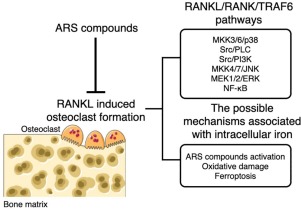Environmental Toxicology and Pharmacology ( IF 4.3 ) Pub Date : 2020-02-27 , DOI: 10.1016/j.etap.2020.103358 Jian Zhang

|
Osteoporosis is a progressive systemic disease characterized by low bone mineral density and deterioration of bone microarchitecture. The current therapies are effective to prevent further bone loss and fractures but they are accompanied by undesirable side effects and cost issues. The discovery of Chinese herbal medicines with osteoprotective effects provides alternative treatments to prevent bone loss without causing severe side effects. Artemisinin (ARS) and its related compounds have been clinically used as antimalarial agents. Interestingly, their bioactivity is not limited to antimalarial treatment. Experimental evidences indicate that ARS compounds are a potential type of therapeutic alternative medicine for bone loss induced by accelerated osteoclastic bone resorption. The present review intends to summarize the current understandings of ARS compounds and their molecular mechanisms of actions in preventing bone loss. ARS compounds selectively inhibit osteoclast differentiation by downregulation of pathways involved in receptor activator of nuclear factor kappa-B ligand (RANKL) -induced osteoclastogenesis, and have no effect on osteogenic differentiation of osteoblasts. The exact mechanism of activation and action of these anti-resorption effects are not fully elucidated. Considering the characteristic of high levels of intracellular iron in osteoclasts, ARS compounds may inhibit osteoclast differentiation via mechanisms associated with intracellular iron, including the cleavage of endoperoxide bridge, oxidative damage and ferroptosis. The anti-resorptive effects of ARS compounds need to be further investigated in bone loss models caused by different factors, and to be under clinical development.
中文翻译:

青蒿素化合物的骨保护作用及其与细胞内铁相关的可能机制:体内和体外研究综述
骨质疏松症是一种进行性全身疾病,其特征在于骨矿物质密度低和骨微结构恶化。当前的疗法有效地防止了进一步的骨丢失和骨折,但是它们伴随着不良的副作用和成本问题。具有骨保护作用的中草药的发现为防止骨质流失而不会引起严重的副作用提供了替代疗法。青蒿素(ARS)及其相关化合物已在临床上用作抗疟药。有趣的是,它们的生物活性不限于抗疟疾治疗。实验证据表明,ARS化合物是潜在的治疗替代药物,可用于加速破骨细胞骨吸收引起的骨丢失。本综述旨在总结当前对ARS化合物及其在预防骨丢失中作用的分子机制的认识。ARS化合物通过下调参与核因子κB配体(RANKL)诱导的破骨细胞形成的受体激活途径而选择性地抑制破骨细胞分化,并且对成骨细胞的成骨分化没有影响。这些抗吸收作用的激活和作用的确切机制尚未完全阐明。考虑到破骨细胞中高水平的胞内铁的特性,ARS化合物可能通过与胞内铁相关的机制抑制破骨细胞的分化,包括内过氧化物桥的裂解,氧化损伤和肥大症。



























 京公网安备 11010802027423号
京公网安备 11010802027423号